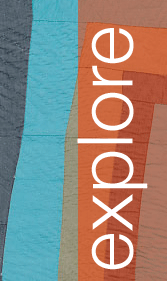BRENDA PETERS
Brenda Peters passed away on February 2, 2004. She was an original member of the Quilts of Gee's Bend in Context Project and the first African American Assistant Professor in the Department of Industrial Design at Auburn University. Professor Peters received a master’s degree in Industrial Design from Auburn University in 1995. Because of her commitment to uplift in Alabama, Professor Peters designed and managed the installation of a science and mathematics technology laboratory for Greensboro East High School, Greensboro, AL 2000. In her work with Ventures in Education, a non-profit organization, she used design as a way to teach core courses better to three academically challenged rural high schools in West Alabama. Professor Peters’ work on the Quilts of Gee's Bend focused on the artistic process evident in their construction. She was interested in researching the psychology of the creative mind and her work on the Quilts of Gee's Bend inspired her to design her own digital quilt. Out of respect for her memory and in gratitude for her spirit we reprint her abstract here.
Abstract
"In Search of my Own Quilt through Explorations of the Creativity of the Women in Gee's Bend"
Brenda Peters
Design and Architecture
Gee's Bend is a small peninsula located in West Alabama which is one of the poorest areas in the state. Yet it has produced some of the most fascinating works of art since the modern movement. The women of Gee's Bend are quilters, unlike artists from the modern movement, which consisted of painters, sculptors, and designers. They turned one of the most ubiquitous household items into art, the quilt.
Because the quilt is such a common item, one cannot help wondering about the fascination with the Gee's Bend quilts. Can we quantify and qualify distinct differences in the pattern, the stitch, the batting, the imperfections, the lack of symmetry, and the figure/ground relationships? What is the unique characteristic of this community that allows these women to produce such extordinary art disguised in the form of a quilt? I would like to hypothesize that this production is due to the environment from which these women were reared and embedded. I can easily discern the creative juices that flow through the blood of these women and their need for self-expression along with the unawareness plagued by modesty that has prevented them from recognizing the beauty (as a high art object) of their own work.
Art is not something that is celebrated as an isolated entity in the deep rural parts of Alabama. It coexists within everyday life and activities. It is unrecognized by the people within the community as being special. It is something that someone just did; it's that simple. The original quilts created in Gee's Bend were made because of a need to keep warm. Due to the need for self-expression, these women created something far greater than an object that kept them warm. In many of the quilts they are deliberated arrangements of color and shape to create an interesting visual affect. However, when inquired about how they created such wonderful works of art many of the replies were just did it without thinking. When creating an object there is a thought process involved. Many times it is so intuitive that it is undetectable even by the artist who is creating the work.
Romeare Breaden, world renowned African-American Artist, produced many of his collages through this process. He simply cut elements from magazines, newspaper clippings, advertisements, whatever was at hand; he then placed them on his canvas and proceeded to arrange them until he felt this was what he wanted to say. There was nothing mystical about art for him; it was part of the air that he breathed and it came natural. However, he being a trained artist was quite aware of how this artistic process worked. The women of Gee's Bend not being trained as artists may feel their creations are simply something that happens. According to theorist of Gestalt psychology the happening is part of a creative process referred to as the aha theory. As one ponders ideas eventually emerges a cathartic moment where the artist/designer decides this is the solution. Without this experience artist would never finish a painting, sculpture, drawing, a quilt, etc. Gestalt psychology makes clear how we interpret and translate visual elements. There are visual clues that signify good arrangement of shape, line and color. The women that created the quilts of Gee's Bend have sublimely gone through this
time and time again. Each quilt that they produced exudes organized relationships that register strong imagery based on Gestaltism. The organization is evident in the viewer's ability to see the whole pattern.
Proposal:
This project will demonstrate the creative process of the Quilters of Gee's Bend. It will show that their process is an intuitive methodical process that is equivalent to trained artist. It will demonstrate this by using Gestalt psychology as a basis to assess the process employed by artists. The paper will include examples of modern artists' works, which will be used to compare the Quilts of Gee's Bend artist to. The comparisons will serve as a way to support the ideal that intuitive creation of art is a legitimate process that is employed by most artists both trained and untrained.


